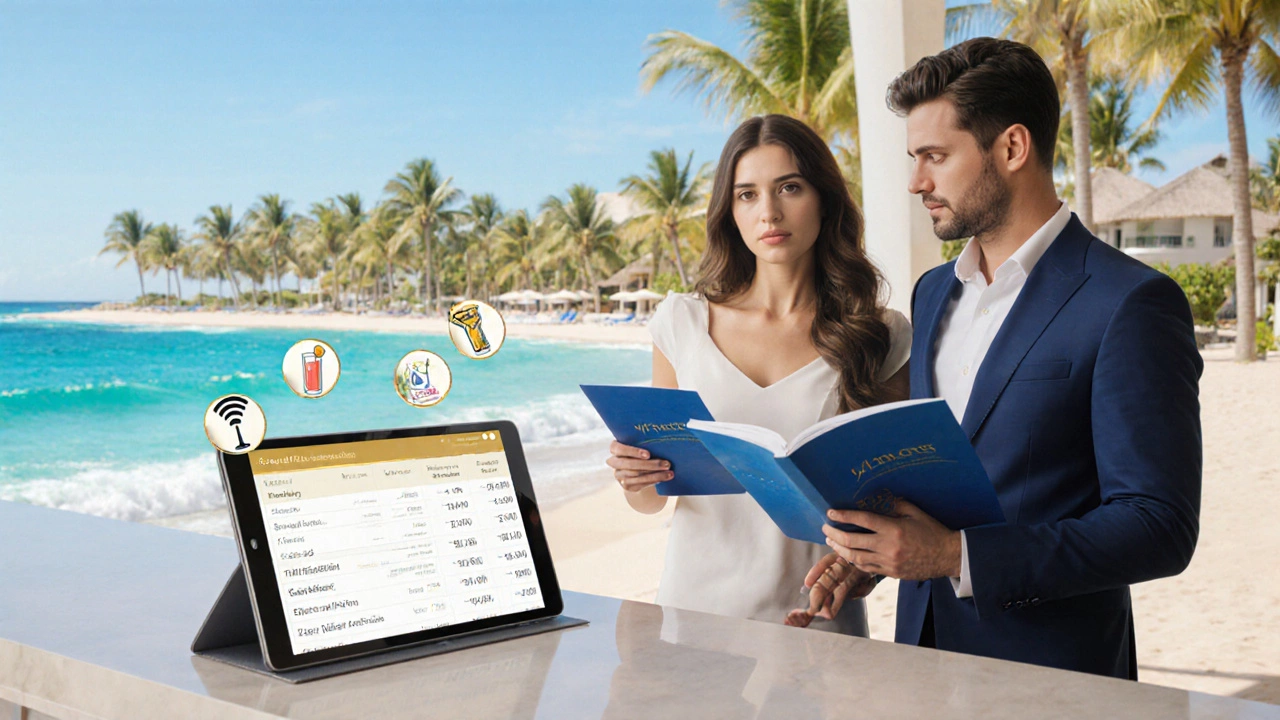All-Inclusive Holiday Cost Calculator
Estimate Your Hidden Costs
Calculate potential extra charges that often aren't included in the base price
Your Estimated Costs
Breakdown
According to the article, 42% of all-inclusive guests reported paying extra for items they thought were covered. Request a detailed price breakdown before booking to avoid sticker shock.
Quick Takeaways
- All‑inclusive packages often hide extra costs that surface later.
- Staying on a resort can limit authentic local experiences.
- High occupancy can strain service quality and personal space.
- Rigid meal and activity schedules reduce flexibility.
- Large resorts can have a noticeable environmental footprint.
Understanding All‑Inclusive Holidays
When you book an All-inclusive holiday is a vacation package where accommodation, meals, drinks, and most on‑site activities are bundled into a single price. The idea sounds simple: pay once, worry less. But the simplicity often masks a set of drawbacks that can turn a dream break into a series of compromises.
1. Hidden Costs and Lack of Price Transparency
Many travelers assume the upfront price includes everything. In reality, Hidden fees extra charges not disclosed in the initial quote, such as premium drinks, specialty restaurants, or resort‑exclusive excursions can add up quickly. A 2023 survey by TravelPulse found that 42% of all‑inclusive guests reported paying extra for items they thought were covered.
Typical surprise costs include:
- Premium alcoholic beverages (top‑shelf spirits, wines by the glass)
- Wi‑Fi packages, especially in remote resorts
- Excursions off the resort grounds (snorkeling trips, guided tours)
- Room service and minibar usage
To avoid sticker shock, request a detailed price breakdown before you book and ask whether items like "premium drinks" are truly included.
2. Limited Interaction with Local Culture
All‑inclusive Resort a self‑contained accommodation complex offering dining, entertainment, and leisure facilities on‑site stays keep you within a fenced perimeter. While this convenience is appealing, it also means fewer opportunities to explore the surrounding town, sample street food, or engage with local artisans.
Travelers seeking authentic cultural immersion often miss out on:
- Traditional markets where bargaining is part of the experience
- Community festivals that showcase regional music and dance
- Family‑run eateries offering dishes that differ from the resort’s standardized menu
Consider allocating one “explorer day” each stay to step outside the resort and experience the genuine Local culture the customs, food, and daily life of the destination’s inhabitants. Booking a guided day trip through a local operator can bridge the gap without sacrificing safety.

3. Overcrowding and Diminished Service Quality
Because the all‑inclusive model promises “everything,” popular resorts often operate at near‑full capacity year‑round. High occupancy can lead to:
- Long waits at buffet lines during peak meals
- Reduced attention from staff, especially during busy evenings
- Shared pool and beach areas that feel more like public parks than private retreats
In a 2022 study by the International Hospitality Association, guest satisfaction dropped by 15% in resorts with occupancy rates above 85%. Choosing a resort with a reputation for maintaining a lower guest‑to‑staff ratio can mitigate this issue.
4. Rigid Meal and Activity Schedules
All‑inclusive packages often operate on set dining times and activity slots. If you’re a night owl, you might find the main buffet closing early. Conversely, early‑bird specials may not suit those who prefer a leisurely brunch.
Activity schedules can be equally inflexible. Popular options like beach volleyball, yoga classes, or themed dinner nights fill up quickly, leaving latecomers unable to participate. To retain flexibility, ask the resort about “a‑la‑carte” dining options or off‑peak activity times.
5. Environmental Impact of Large Resorts
Mass‑scale resorts consume substantial resources-water, energy, and food-often sourced from far‑away suppliers. The carbon footprint of transporting thousands of meals daily can be significant.
Some resorts have adopted sustainability certifications (e.g., Green Globe), but many still rely on single‑use plastics and over‑irrigated lawns. According to a 2024 UNEP report, tourism‑related accommodation accounts for 8% of global CO₂ emissions, with all‑inclusive resorts contributing a sizable share due to high energy usage.
If eco‑conscious travel matters to you, research resorts that publish their environmental policies, use renewable energy, or participate in beach clean‑up programs.

6. Health and Safety Risks
Buffet‑style dining can pose food‑borne illness risks if hygiene standards slip. In 2021, a Mediterranean all‑inclusive chain reported a norovirus outbreak affecting 4% of guests.
Medical facilities on‑site may be limited to basic first‑aid. For serious conditions, you might need to travel to the nearest town, which can be inconvenient. Securing Travel insurance coverage that protects against medical emergencies, trip cancellations, and other travel‑related risks that includes comprehensive medical repatriation is advisable.
7. How to Navigate These Drawbacks
Knowing the potential downsides lets you plan smarter. Here are practical steps to enjoy an all‑inclusive holiday while minimizing the cons:
- Ask for a detailed price breakdown. Verify which drinks, excursions, and services are truly included.
- Schedule at least one “off‑resort” day. Use local transport or reputable tour operators to explore nearby towns.
- Read recent guest reviews focusing on service speed and crowd levels during your intended travel dates.
- Choose resorts that offer flexible dining (e.g., on‑site à‑la‑carte restaurants) and a variety of activity times.
- Prioritize environmentally certified properties. Look for certifications like Green Key or EarthCheck.
- Purchase comprehensive travel insurance that covers medical emergencies and unexpected cancellations.
- Pack a reusable water bottle and a few snacks to reduce reliance on buffet lines and cut down on waste.
By taking these steps, you can retain the convenience of an all‑inclusive package while sidestepping many of its common pitfalls.
Frequently Asked Questions
Are all‑inclusive meals really unlimited?
Most resorts offer unlimited access to the main buffet and standard drinks, but premium items like top‑shelf spirits, specialty coffees, or à‑la‑carte dishes often come with an extra charge.
Can I leave the resort and still keep my all‑inclusive price?
The price covers what happens on‑site. If you venture off‑resort, you’ll pay for transportation, meals, and any extra activities separately.
Do all‑inclusive resorts have eco‑friendly practices?
Only a subset do. Look for certifications like Green Globe, EarthCheck, or local sustainability awards. Those resorts typically reduce single‑use plastics, source food locally, and invest in renewable energy.
What hidden fees should I watch out for?
Premium alcohol, Wi‑Fi, spa treatments, special excursions, and sometimes even “taxes” that are not included in the advertised price.
Is travel insurance necessary for an all‑inclusive vacation?
Yes. Good coverage protects you against medical emergencies, trip cancellations, and unexpected extra costs that aren’t covered by the resort package.
Bottom Line
All‑inclusive holidays can be a fantastic way to simplify budgeting and enjoy hassle‑free amenities, but they come with trade‑offs-hidden costs, limited local exposure, crowding, rigidity, and environmental concerns. By asking the right questions, reading recent reviews, and planning a few off‑site adventures, you can get the best of both worlds: the convenience of an all‑inclusive package without paying for its common downsides.
